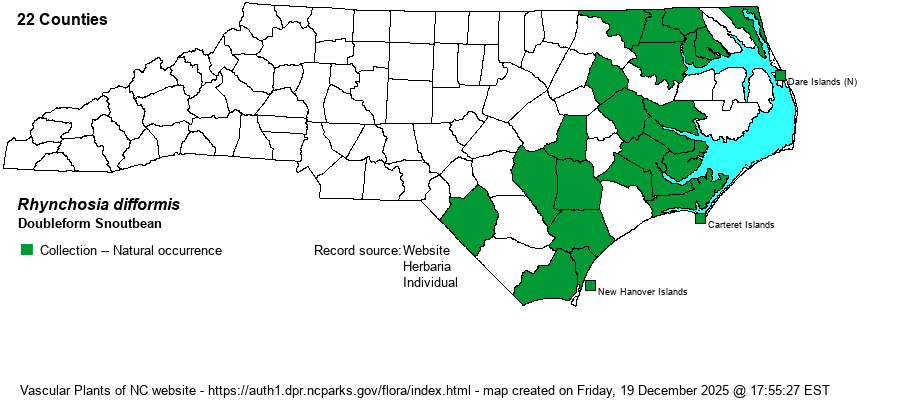| Author | (Elliott) de Candolle | |
| Distribution | Scattered over the eastern and central Coastal Plain, but not present in the Sandhills region. A number of holes in the range, especially in counties north and south of Albemarle Sound.
This is a mainly Coastal Plain species, ranging north to eastern VA, and south to southern FL and west to southeastern TX. | |
| Abundance | Uncommon over most of the range, but can be at least infrequent in some southern coastal areas. It likely has declined in recent years owing to development, and less to fire suppression and other factors. As photos on iNaturalist are only from the northern Dare County Outer Banks and coastal New Hanover, the editors are suggesting a rarer State Rank of S2S3. | |
| Habitat | This is a species of sandy soil, less so of other dry soils, often under an open hardwood canopy. It can be found in pine/scrub oak sandhills, in Mainland Maritime Forests and Maritime Evergreen Forests, as well as sandy openings and on backdunes. Many such places are prime sites for development, and seemingly very few of its locations are in protected or managed natural areas. |
| Phenology | Blooms from June to August, and fruits from July to October. | |
| Identification | This is a trailing herb, but it grows only to 2-3 feet long, and normally it is not climbing. As with so many other legumes, the leaves are divided into 3 leaflets. The leaves are somewhat widely scattered along the stem, and each leaflet is almost round in shape, about 2 inches long and across, with the lateral leaflets similar but slightly more elliptical, but still somewhat rotund. The leaflets can be somewhat narrower in some plants or populations, however -- noticeably longer than wide. However, the leaflets are very heavily veined on the top side, with the veins distinctively sunken, which should separate the species from other 3-parted vine-like legumes. From some leaf axils grow rather short flowering stalks (only about 1 inch long), topped by a number of small yellow flowers densely packed at the end of the stalk. Though the other two native Rhynchosia species in the state have similar flower clusters, and similar rounded leaflets with heavily sunken veins, each is quite different. R. tomentosa is an erect species, not a trailing "vine"; whereas R. reniformis is not only erect but it has 1-foliate leaves (i.e., the leaf is not divided into 3 leaflets). The exotic R. americana has apparently been recorded in NC just on one occasion; it is vine-like but has undivided leaves. Sadly, R. difformis is not normally an easy species to find, as it theoretically can occur in a number of sandy soil locations, even along roadbanks or roadsides, and not necessarily in pristine habitats. It is much less often seen than the other two native species in the genus, and thus it is always notable when you do run across it. | |
| Taxonomic Comments | None
| |
| Other Common Name(s) | Twining Snoutbean, Climbing Snoutbean | |
| State Rank | S3 [S2S3] | |
| Global Rank | G5? | |
| State Status | | |
| US Status | | |
| USACE-agcp | | |
| USACE-emp | | |

